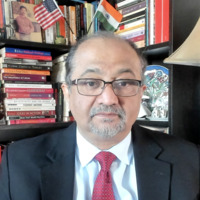
Eric Schluessel
My research program explores the social history of the Qing empire (1644–1911) and its legacies in modern China, with particular attention to Xinjiang, China’s Muslim-majority borderland. Temporally, it is rooted in China’s era of civil war and reconstruction, from the mid-nineteenth century into the early twentieth. This gives me a dual professional identity: I am a social historian of late imperial and modern China, and at the same time a cultural historian of Islamic Central Asia. That duality opens up a space for comparative and transregional inquiry that decenters the Euro-American experience. Close engagement with histories of colonialism as well as multilingual archival research inform my explorations of difference and power along the Sino-Islamic frontier of Central Asia and in rural China proper.
Land of Strangers: The Civilizing Project in Qing Central Asia (Columbia, 2020), exemplifies this approach. It examines the sociocultural ramifications of post-war reconstruction in Xinjiang between 1877 and 1911, during which period a clique of Confucian fundamentalists undertook a project to transform the region’s Turkic-speaking Muslim majority into Chinese-speaking Confucians. I argue that this civilizing project articulated with the trauma of mass violence, and in particular mortuary politics, in ways that transformed sexual and economic relations and led people to reimagine their communities around myths of common descent. The roots of the contemporary ethnonational conflict for which Xinjiang is known can thus be found in part in the Islamic reception of a mission of religious conversion rooted in Chinese ideas and practices. Land of Strangers received the 2021 Fairbank Prize.
Work on my book manuscript led me to translate the Tarikh-i Ḥamidi by Musa Sayrami, the essential chronicle of the Uyghur region's tumultuous nineteenth century by a person from the region. This first-ever English translation was published by Columbia in 2023, and it has opened up a number of further questions about narrative, power, and socioeconomic organization grassroots. Those themes now dominate much of my work.
Supervisors: Mark Elliott, Michael Szonyi, Ildikó Bellér-Hann, and William Alford
Land of Strangers: The Civilizing Project in Qing Central Asia (Columbia, 2020), exemplifies this approach. It examines the sociocultural ramifications of post-war reconstruction in Xinjiang between 1877 and 1911, during which period a clique of Confucian fundamentalists undertook a project to transform the region’s Turkic-speaking Muslim majority into Chinese-speaking Confucians. I argue that this civilizing project articulated with the trauma of mass violence, and in particular mortuary politics, in ways that transformed sexual and economic relations and led people to reimagine their communities around myths of common descent. The roots of the contemporary ethnonational conflict for which Xinjiang is known can thus be found in part in the Islamic reception of a mission of religious conversion rooted in Chinese ideas and practices. Land of Strangers received the 2021 Fairbank Prize.
Work on my book manuscript led me to translate the Tarikh-i Ḥamidi by Musa Sayrami, the essential chronicle of the Uyghur region's tumultuous nineteenth century by a person from the region. This first-ever English translation was published by Columbia in 2023, and it has opened up a number of further questions about narrative, power, and socioeconomic organization grassroots. Those themes now dominate much of my work.
Supervisors: Mark Elliott, Michael Szonyi, Ildikó Bellér-Hann, and William Alford
less
Related Authors
Noel B. Salazar
KU Leuven
Muqtedar Khan
University of Delaware
Bilal Orfali
American University of Beirut
Sheilagh Ogilvie
University of Oxford
B. Harun Küçük
University of Pennsylvania
Armando Salvatore
McGill University
Katherine Butler Schofield
King's College London
Lik Hang Tsui
City University of Hong Kong
Alejandra B Osorio
Wellesley College
Robert Knox
University of Liverpool
InterestsView All (21)










Uploads
Books by Eric Schluessel
Papers by Eric Schluessel
The late- Qing reintegration of Xinjiang into the empire was not only a political and military event, but one that effected a transformation in the region's cultures and societies. This article investigates the religious life of Hunanese people in Xinjiang during that time, focusing on their worship of the deities Dingxiang Wang and Fangshen. These two deities' various legends reflect the experiences of Xiang Army soldiers on their march from Hunan and their development of a sense of belonging after settling in Xinjiang This article reconstructs the origins of Dingxiang Wang through scattered oral histories and written records.
Here's a link to the searchable online version! It's also available as a PDF.
Edited volumes by Eric Schluessel
Not long ago, we entered a new millennium. Among Inner Asian Turkic populations, where societies are developing and growing with this new millennium, there is a search for cultural historical legacies with the aim of identifying features of nationhood or arriving at some related comprehension of belonging to a specific societal community.
History means “past” – near past or remote past. Does this search for a cultural historical identity entail efforts to resuscitate, or revitalize, cultural features or patterns from the past? Is it possible to revive cultural patterns belonging to another era? The territory – the geographical area – is the same as it was in the past. Its inhabitants are people with memories and narrations of traditions and life among ancestors living on the same territory during long stretches of time. How is this past to be accessed and how is it to be interpreted by present-day man, in another era and in a world where people’s lives are lived in quite another fashion and under quite different conditions from those of bygone days?
In a more general perspective, it is often stated by those who are cautious about traditions andlegacies that societies need to rest on history. If this is true and if societies do in fact need their history, why is this so and, furthermore, what is it that constitutes our knowledge of past times, our knowledge of our own past? How is historical knowledge created and how is it to be narrated in order to become historical knowledge for future generations? What is envisioned in historical narration and where do we look in order to find that which can be turned into historical knowledge? Finally, what may trigger revisions of such narration? These are questions central to the accounts offered in the following chapters of the present book.
The need and search for cultural and historical images may seem to be determined and influenced to a considerable degree by current political circumstances at different levels – not least regional and other levels beyond the individual state. Some of the chapters focus on such synchronic circumstances rather than long-term historiographies. Nevertheless, whatever temporal settings and geographical extensions are chosen, all presentations are contributions to the study of nation building or – with the term used in one of the ensuing chapters – “nation branding”.
The first two contributions to the present volume are accounts from broad regional and interregional perspectives drawing attention to current post-Soviet changes in terms of both political conditions and identity formation. The chapter On Oral History of the Soviet Past in Central Asia by Timur Dadabaev, Tsukuba University, addresses methodological issues relating to the question as to how new historiographies could also be shaped by common-man “lived” experiences elicited from personal memories of the Soviet past by elderly people who were once Soviet citizens living in Uzbekistan, Kazakhstan or Kyrgyzstan.
In her chapter, The Coverage of Central Asia in Turkey, the Turkish scholar Büşra Ersanlı from Marmara University, Istanbul, comments on the development and modifications of Turkey’s foreign policy towards the young ex-Soviet Central Asian states and the endeavors of this country to determine its role as one – and in many respects the leading – member of a large Turkic world where coordination and cooperation have gained greater potentials than ever before.
Emre Gürbüz, Kyrgyzstan-Turkey Manas University, Bishkek, with his chapter titled In Search of New Historiographies for Ex-Soviet Turkic States, likewise includes Turkey in his survey of works on new history writing in Azerbaijan, Uzbekistan, and Kazakhstan. This time the former country is contrasted to the latter three republics from the point of view of territoriality, which the author identifies as “one of the main characteristics of post-Soviet historiographies”. The three ex-Soviet republics under investigation are shown to base their claims on legitimacy as sovereign states on “conventional territorial understanding”, albeit under partly different socio-political legacies and, furthermore, with differing visions as to future objectives for their respective nation-states.
The account of History-Writing and History-Making in Azerbaijan by Zaur Gasimov at the German Orient-Institut Istanbul could be read as a comment on such future objectives as regards one of these three states – Azerbaijan. The author offers a thorough survey of new trends in post-Soviet Azerbaijani history-writing with regard to both the choice of topics and interpretation as well as language (Azerbaijani rather than Russian) and style, although there amy be new obstacles and taboos due to present-day policies.
From the perspective of “a post-modern world of images and influence”, Anita Sengupta, fellow of the Maulana Abul Kalam Azad Institute of Asian Studies, Kolkata, takes the Republic of Uzbekistan under scrutiny in a chapter subtitled The Politics of Nation Branding in Uzbekistan. There she writes that “modern nations are in actuality based on invented traditions and the continuous mobilization and adaptation of history” in order to “reposition themselves in a fluid globalizing world” and that “nation-state building is no longer an activity confined to the domestic arena”.
The significance of language in sociopolitical development and nation building is highlighted in the remaining three chapters of this volume. Two of them focus on the language situation in Uzbekistan and the interdependence of language and identity formation, whereas the third chapter deals with language development in the late 19th-century Xinjiang. Rano Turaeva-Hoehne, Max Planck Institute for Social Anthropology, Halle, refers to ethnographic fieldwork among Khorezmian migrants in Tashkent when commenting on the use of different linguistic codes “for communicating collective and social identities in a multiethnic context”, in her paper concerning Linguistic and Social Contradictions within Uzbek National Identity.
In her chapter titled The Status of Uzbek as “National Language” the SRII Director Birgit N. Schlyter, Istanbul, examines the post-Soviet Uzbek state language from the point of view of three parameters – “distribution”, “corpus”, and “manifestation” – for an evaluation of the chances for this language to become a symbol of Uzbekistani national identity. In particular the third parameter is crucial relating to the “narrative capacity” of language and the loyalty towards a state or community through language.
The author of Language and State in Late Qing Xinjiang, Eric T. Schluessel from Harvard University, wants to show how the very concept of language changed in the final years of Qing rule and writes that language “was conceived of not just as a system of varieties marking kinds of people, but as an instrument of reform and an institution of power”. He describes a rather complex language situation that could not be characterized merely in terms of one language community (Chinese) dominating another (Turki). For a general comment on the relationship between language and society, he finds it “useful to examine national identity and language attitudes as part of an ongoing process of negotiation between state and other actors promoting competing language regimes and linguistic institutions”.
The authors of these chapters have all been participating in research work conducted within the framework of the Stockholm International Program for Central Asian Studies (SIPCAS). Their contributions originate from papers presented at conferences and workshops arranged or co-organized by SIPCAS for discussions of societal change and transformation in the wake of the Soviet demise. Issues of cultural historical legacies and nation-state legitimacy have been at the top of the agenda.
As usual, the spelling of names and titles has been an intricate issue, the more so as variations are due to not only personal preferences but also the fact that different alphabets (e.g. Cyrillic or Latin for Azerbaijani names) may have been used for one and the same reference. There has been homogenization to a certain degree, especially in the spelling of scientific terms, linguistic and others (e.g. Kipchak, not Kypchak or Qipchaq). Moreover, American spelling has been chosen whenever there has been an option contrasting with a British alternative. In certain cases, on the other hand, the authors have been free to use a spelling of their own choice, independent of the spelling of the same word or name in another chapter (e.g. Uyghur in one chapter versus Uighur in another).
The abovementioned SIPCAS program encourages and welcomes the participation of young researchers and students. During work on the manuscript of this volume much help was offered by Nina Lind while on a one-month internship at the Swedish Research Institute in Istanbul and by Azize Güneş, who was my assistant throughout the whole editing process and shared the proofreading of all chapters with me. It was a great pleasure to work with them, and I’m much obliged to their cautious efforts.
Istanbul, May 2014
The Editor
Book Reviews by Eric Schluessel
The late- Qing reintegration of Xinjiang into the empire was not only a political and military event, but one that effected a transformation in the region's cultures and societies. This article investigates the religious life of Hunanese people in Xinjiang during that time, focusing on their worship of the deities Dingxiang Wang and Fangshen. These two deities' various legends reflect the experiences of Xiang Army soldiers on their march from Hunan and their development of a sense of belonging after settling in Xinjiang This article reconstructs the origins of Dingxiang Wang through scattered oral histories and written records.
Here's a link to the searchable online version! It's also available as a PDF.
Not long ago, we entered a new millennium. Among Inner Asian Turkic populations, where societies are developing and growing with this new millennium, there is a search for cultural historical legacies with the aim of identifying features of nationhood or arriving at some related comprehension of belonging to a specific societal community.
History means “past” – near past or remote past. Does this search for a cultural historical identity entail efforts to resuscitate, or revitalize, cultural features or patterns from the past? Is it possible to revive cultural patterns belonging to another era? The territory – the geographical area – is the same as it was in the past. Its inhabitants are people with memories and narrations of traditions and life among ancestors living on the same territory during long stretches of time. How is this past to be accessed and how is it to be interpreted by present-day man, in another era and in a world where people’s lives are lived in quite another fashion and under quite different conditions from those of bygone days?
In a more general perspective, it is often stated by those who are cautious about traditions andlegacies that societies need to rest on history. If this is true and if societies do in fact need their history, why is this so and, furthermore, what is it that constitutes our knowledge of past times, our knowledge of our own past? How is historical knowledge created and how is it to be narrated in order to become historical knowledge for future generations? What is envisioned in historical narration and where do we look in order to find that which can be turned into historical knowledge? Finally, what may trigger revisions of such narration? These are questions central to the accounts offered in the following chapters of the present book.
The need and search for cultural and historical images may seem to be determined and influenced to a considerable degree by current political circumstances at different levels – not least regional and other levels beyond the individual state. Some of the chapters focus on such synchronic circumstances rather than long-term historiographies. Nevertheless, whatever temporal settings and geographical extensions are chosen, all presentations are contributions to the study of nation building or – with the term used in one of the ensuing chapters – “nation branding”.
The first two contributions to the present volume are accounts from broad regional and interregional perspectives drawing attention to current post-Soviet changes in terms of both political conditions and identity formation. The chapter On Oral History of the Soviet Past in Central Asia by Timur Dadabaev, Tsukuba University, addresses methodological issues relating to the question as to how new historiographies could also be shaped by common-man “lived” experiences elicited from personal memories of the Soviet past by elderly people who were once Soviet citizens living in Uzbekistan, Kazakhstan or Kyrgyzstan.
In her chapter, The Coverage of Central Asia in Turkey, the Turkish scholar Büşra Ersanlı from Marmara University, Istanbul, comments on the development and modifications of Turkey’s foreign policy towards the young ex-Soviet Central Asian states and the endeavors of this country to determine its role as one – and in many respects the leading – member of a large Turkic world where coordination and cooperation have gained greater potentials than ever before.
Emre Gürbüz, Kyrgyzstan-Turkey Manas University, Bishkek, with his chapter titled In Search of New Historiographies for Ex-Soviet Turkic States, likewise includes Turkey in his survey of works on new history writing in Azerbaijan, Uzbekistan, and Kazakhstan. This time the former country is contrasted to the latter three republics from the point of view of territoriality, which the author identifies as “one of the main characteristics of post-Soviet historiographies”. The three ex-Soviet republics under investigation are shown to base their claims on legitimacy as sovereign states on “conventional territorial understanding”, albeit under partly different socio-political legacies and, furthermore, with differing visions as to future objectives for their respective nation-states.
The account of History-Writing and History-Making in Azerbaijan by Zaur Gasimov at the German Orient-Institut Istanbul could be read as a comment on such future objectives as regards one of these three states – Azerbaijan. The author offers a thorough survey of new trends in post-Soviet Azerbaijani history-writing with regard to both the choice of topics and interpretation as well as language (Azerbaijani rather than Russian) and style, although there amy be new obstacles and taboos due to present-day policies.
From the perspective of “a post-modern world of images and influence”, Anita Sengupta, fellow of the Maulana Abul Kalam Azad Institute of Asian Studies, Kolkata, takes the Republic of Uzbekistan under scrutiny in a chapter subtitled The Politics of Nation Branding in Uzbekistan. There she writes that “modern nations are in actuality based on invented traditions and the continuous mobilization and adaptation of history” in order to “reposition themselves in a fluid globalizing world” and that “nation-state building is no longer an activity confined to the domestic arena”.
The significance of language in sociopolitical development and nation building is highlighted in the remaining three chapters of this volume. Two of them focus on the language situation in Uzbekistan and the interdependence of language and identity formation, whereas the third chapter deals with language development in the late 19th-century Xinjiang. Rano Turaeva-Hoehne, Max Planck Institute for Social Anthropology, Halle, refers to ethnographic fieldwork among Khorezmian migrants in Tashkent when commenting on the use of different linguistic codes “for communicating collective and social identities in a multiethnic context”, in her paper concerning Linguistic and Social Contradictions within Uzbek National Identity.
In her chapter titled The Status of Uzbek as “National Language” the SRII Director Birgit N. Schlyter, Istanbul, examines the post-Soviet Uzbek state language from the point of view of three parameters – “distribution”, “corpus”, and “manifestation” – for an evaluation of the chances for this language to become a symbol of Uzbekistani national identity. In particular the third parameter is crucial relating to the “narrative capacity” of language and the loyalty towards a state or community through language.
The author of Language and State in Late Qing Xinjiang, Eric T. Schluessel from Harvard University, wants to show how the very concept of language changed in the final years of Qing rule and writes that language “was conceived of not just as a system of varieties marking kinds of people, but as an instrument of reform and an institution of power”. He describes a rather complex language situation that could not be characterized merely in terms of one language community (Chinese) dominating another (Turki). For a general comment on the relationship between language and society, he finds it “useful to examine national identity and language attitudes as part of an ongoing process of negotiation between state and other actors promoting competing language regimes and linguistic institutions”.
The authors of these chapters have all been participating in research work conducted within the framework of the Stockholm International Program for Central Asian Studies (SIPCAS). Their contributions originate from papers presented at conferences and workshops arranged or co-organized by SIPCAS for discussions of societal change and transformation in the wake of the Soviet demise. Issues of cultural historical legacies and nation-state legitimacy have been at the top of the agenda.
As usual, the spelling of names and titles has been an intricate issue, the more so as variations are due to not only personal preferences but also the fact that different alphabets (e.g. Cyrillic or Latin for Azerbaijani names) may have been used for one and the same reference. There has been homogenization to a certain degree, especially in the spelling of scientific terms, linguistic and others (e.g. Kipchak, not Kypchak or Qipchaq). Moreover, American spelling has been chosen whenever there has been an option contrasting with a British alternative. In certain cases, on the other hand, the authors have been free to use a spelling of their own choice, independent of the spelling of the same word or name in another chapter (e.g. Uyghur in one chapter versus Uighur in another).
The abovementioned SIPCAS program encourages and welcomes the participation of young researchers and students. During work on the manuscript of this volume much help was offered by Nina Lind while on a one-month internship at the Swedish Research Institute in Istanbul and by Azize Güneş, who was my assistant throughout the whole editing process and shared the proofreading of all chapters with me. It was a great pleasure to work with them, and I’m much obliged to their cautious efforts.
Istanbul, May 2014
The Editor